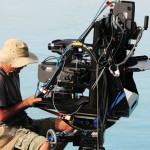By John Parnell www.arabianbusiness.com
Solid test and measurement infrastructure is essential to keep advertisers and audiences happy. Getting the right balance between thorough safeguards and costly overkill is just one challenge broadcasters face in an environment of emerging formats and rising expectation.

The downturn may have helped produce larger TV audiences and longer total daily viewing hours, but for broadcasters, the value of each individual subscriber (or in the case of FTA channels every eyeball) is higher than ever.
In the current climate, customer retention is vital to ensure that ground gained, can be held.
“Poor video service impacts viewership significantly and therefore can be very damaging to a TV operator and its business,” says Ralph Bachofen, VP of sales and head of marketing, Triveni Digital.
“Viewers needn’t be particularly discerning to notice issues with digital TV signals. Common issues that are particularly visible to subscribers are video tiling, lip sync errors, missing audio channels, intermittent tuning, and missing components. As most TV operators have probably discovered, viewers very rarely tolerate interruption or degradation in the quality of picture or audio,” claims Bachofen.
“For the TV operator, the key to keeping the viewer – whether discerning or not – satisfied is to analyse not only video, but also audio, data, and metadata, examining the MPEG transport layer continuously and comprehensively,” he says.
So with plenty of errors still to spot with digital transmissions, are viewers now more aware of these problems and more likely to act on them than they were in the days of analogue?
“Audiences today are much more savvy. They have seen how good digital television can be and they become vocal when it does not meet their expectations,” says Steve Nunney, managing director, Hamlet.
“The broadcaster’s unique selling point, is quality, with reliable high resolution and freedom from dropouts and stutters. Why would you want to risk that unique high ground?” he asks.
Viewers may be aware of problems and naturally become frustrated by them, but changing channel and cancelling subscriptions are quite drastic measures. Each viewer must have a threshold for quality of service that if not satisfied, triggers a response. What affect does this have on a broadcasters reputation?
“A pretty catastrophic one. Customers have a high threshold before they do anything about a problem but if issues remain consistent for months, they will suddenly start experiencing a lot of churn,” says Simen Frostad, president, Bridge Technologies. “Then the more catastrophic loss is when you lose the signal for hours, which is a terrifying prospect. Both scenarios can be pretty disastrous from a commercial point of view, especially if the slow trickling kind of problem where you have a consistently bad signal – artefacts every ten minutes for instance – slowly this will take its toll and audiences will turn elsewhere.”
Keeping audiences happy is only one part of the incentive for maintaining a high quality of service with advertisers also keen to ensure their wares are presented in all their glory.
“Without audiences and advertisers, you do not have a business,” says Hamlet’s Nunney.
Audiences have a huge choice of channels, and a huge choice of sources of entertainment and information and advertisers want their products to look good.
“They take enormous care to make their commercials striking and the packshot colourimetry to be precise. They will be reluctant to pay to put their commercials on a channel tat does not reflect that care. If they do book commercials and are not happy with the way they are transmitted, they will not pay,” claims Nunney.
“The message is clear: if you attract an audience then you will interest advertisers; if you look after those advertisers, you will keep them booking slots; if you take advertising revenue, you will have a profitable business. That is why quality matters.”
Theoretically, the best possible achievable quality in digital TV should be perfection, but is this an achievable goal for broadcasters or a technical and commercial implausibility?
“Technically, perfection probably is achievable in a digital TV network and can be ensured through the proper use and placement of intelligent monitoring devices,” says Triveni’s Bachofen. “However, it simply is not feasible to deploy monitoring devices everywhere in a network. Hence, TV operators can strive instead to achieve a cost-effective balance that leverages both tactical analysis and strategic monitoring.”
This a sentiment echoed by Nunney.
“First, we have to consider what perfect means. All digital television is, by its very nature, a compromise, first in the sampling rate at the time of capture, then in the degree of compression that is imposed to make it practical to transmit.
“A lot of very clever and experienced minds have gone into developing those compression algorithms to ensure that they are as close to perfection as it is possible to be, so that the viewer sees and hears excellent quality. It is then up to the broadcaster to make the most of the technology available to achieve that ‘perfection’,” says Nunney.
“It means accurate testing of signals at every point where they might get distorted: on the shoot, during post production, as graphics are added, and so on. Ensuring that sound and vision consistently fills the available dynamic range and gamut, can only be achieved through excellent attention to quality control.”
Frostad believes in the deep monitoring either side of a conditional access system too.
“The CA operator is always the first person to say “no it’s not the CA” and it is then up to the broadcaster to try to prove it. So again the philosophy is to have a particular level of monitoring and analytics capabilities at all kinds of production points where you transform the signal one way or another,” explains Frostad.
So while perfection may be an attainable goal, it is one that is beyond the call of duty for broadcasters that can reach acceptable quality goals by deploying their monitoring systems intelligently rather than copiously.
“You don’t need tonnes of equipment you just it all to be in the correct places in the network,” says Frostad. “Broadcasters need to have valid monitoring on all the key points on the network. The market is starting to reach maturity and the operators that know what they are doing will have adequate equipment in their network. They already know they need to maintain a decent service.”
Frostad believes that as a minimum, monitoring must be deployed at all the handover points on a network, such as either side of a leased fibre optic line to avoid any “finger pointing”. Accountability is a secondary benefit of an adequate monitoring environment allowing the point of failure – and the responsible party – to be readily identified.
Having adapted to the digital television environment and the increased scrutiny of the HD world, test and measurement equipment manufacturers are now having to develop the tools necessary for 3D broadcasting as well.
“We’re interested in 3D monitoring. Though it does require some added signalling, 3D is contained within the MPEG stream just as any other video signal would be, and 3D content is subject to the same rules as 2D content,” says Bachofen. “The basic timing and buffer models, for example, are the same for 2D and 3D broadcasts. At the video level, further syntax – the nature of which depends upon the system being used – enables the actual 3D viewing experience. Triveni Digital monitoring and analysis systems can be employed both for conventional broadcasts and for new 3D services.”
Hamlet’s Nunney believes much of the work in broadcasting acceptable 3D content must be done during the production itself.
“The message we are getting loud and clear from everyone who is doing stereo 3D, is that it is vital to get as much right as possible on the shoot,” says Nunney. “Fixing things in post is really not a practical proposition – the costs are too large. You must get the basics – black level, gain for example – right on location, and they have to be perfectly matched between the two cameras in a pair. That means you need a tool like the Hamlet VidScope 3D, that lets you measure these parameters independently but also compare them directly, so you can quickly but very accurately ensure the perfect match.”



















